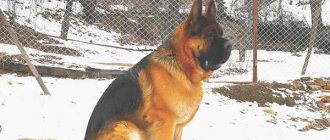Dogs of the Collie (Scottish Sheepdog) and Sheltie (Shetland Sheepdog) breeds are very similar in appearance, so they are often confused, mistaking the Sheltie for a mini copy of the Collie. Or, because Shelties are smaller in size, they are sometimes mistaken for Collie puppies.
Yes, indeed, there are breeds that have mini-varieties. They differ only in size. For example, Dachshunds and Mini Dachshunds, Maltese and Mini Maltese. But this in no way applies to Sheltie and Collie. These are two different independent breeds . They differ not only in size, but also in a number of other characteristics, which we will discuss in this article.
What is the difference between Collies and small Shelties? Main differences and minor ones
Dogs of the Collie (Scottish Sheepdog) and Sheltie (Shetland Sheepdog) breeds are very similar in appearance, so they are often confused, mistaking the Sheltie for a mini copy of the Collie.
Or, because Shelties are smaller in size, they are sometimes mistaken for Collie puppies. Yes, indeed, there are breeds that have mini-varieties. They differ only in size. For example, Dachshunds and Mini Dachshunds, Maltese and Mini Maltese. But this in no way applies to Sheltie and Collie. These are two different independent breeds . They differ not only in size, but also in a number of other characteristics, which we will discuss in this article.
How to train a Sheltie?
Rule number one in puppy training is to build a relationship with your dog based on mutual trust and respect. Therefore, before you begin obedience training, the first step should be to establish a bond with your dog. Not only will this help you understand his needs and instincts, but it will also help him develop trust in you.
When puppies reliably understand that they belong to a family, they are more likely to respond to your commands. The trust you build early in life comes from showing affection, setting mutual boundaries, and being kind but firm in the face of any infractions.
At our last annual meeting of shareholders, we decided to purchase more peanut butter futures
At our last annual meeting of shareholders, we decided to purchase more peanut butter futures
I recommend clicker training as a gentle, free-to-play dog training method that uses only positive reinforcement to teach your Sheltie tricks and obedience.
It's very simple. Based on positive reinforcement, the sound of a click reinforces the dog's habit of listening and responding to your commands. Once the dog is trained, a click tells him to obey. Thanks to psychological training (a natural way of learning for both dogs and people), you can quickly introduce new behaviors and commands to your smart little dog.
Origin
No matter how paradoxical it may sound, it is the different origins that explain both the similarities and differences between these breeds.
The Collie's homeland is on the border of Northern England and Scotland. Initially, it was a herding dog adapted for working needs - strong, squat, with warm, shaggy hair, allowing it to survive outdoors in a rather harsh climate.
Subsequently, breeders worked significantly with the breed, adding the blood of Scottish and Irish Setters, Greyhounds and other breeds. Thanks to them, Collie not only became more resilient, but also acquired an aristocratic appearance.
The Sheltie was also originally a herding dog, the only difference being that it originated from the Shetland Islands. Her ancestors were small dogs similar to Spitz. They owe their modern appearance to crossings with King Charles Spaniels, Spitz, Papillon, Schipperke and Collie.
The Sheltie inherited its appearance from the Scottish Shepherds . Thanks to this, they are so similar in appearance. But other breeds influenced the character and temperament of Shetland Sheepdogs, making them different from Collies.
Difference in size and appearance
- The main, glaring difference in the photo is the size of the dogs. According to breed standards, for a Scottish Sheepdog the height at the withers should be between 51-61 cm, and for a Sheltie - 33-39 cm.
- The second important difference lies in color - three standard coat colors are acceptable for Collies, while Shelties have five.
- In addition, these dogs have different head shapes - the Scottish Sheepdog is narrower and longer at the base, while the Shetland Sheepdog is shorter and wider, and also has a more defined transition from the forehead to the muzzle.
- Compared to the Collie, the Sheltie's ears are wider at the base and set closer together, and her eyes are larger relative to the size of her head.
What is the difference between intelligence
Both of these breeds are highly intelligent dogs. They are easy to train and can learn many commands without being stubborn.
Both of these breeds are emotionally very attached to their owners and try to please them, anticipating their desires . It is not difficult for them to adapt to the lifestyle of their owner. Both Collie and Sheltie are great with children, acting as a nanny. They generally have no desire to dominate. They do not strive to show “who’s boss.” However, these intellectuals of the dog world, if necessary, are able to act independently, choosing the right decision.
When can I take a puppy home?
Puppies should not be separated from their mother until they are at least 8 weeks old. If this happens earlier, the puppy usually becomes nervous and cannot settle into his new home.
Puppies should settle into their new family by 12 weeks, when they have formed a strong bond. Therefore, 8-12 weeks is the best time to take a puppy home, and responsible breeders will ensure that this time limit is met.
If you're considering adopting a puppy, check out these 20 things you need for your new puppy before you bring him home.
Puppies can be rehomed from 8 weeks of age
Puppies can be rehomed from 8 weeks of age
Differences in Temperament
Both Scottish and Shetland Sheepdogs have a cheerful and cheerful disposition. They absolutely cannot tolerate cruel treatment or physical punishment . It is much more effective to reprimand the dog; moral punishment will work faster.
The difference is that the Collie is calmer and more reasonable. And the little Sheltie is more active and energetic. And if on the street dogs of both breeds will happily run around the lawn, then at home Collie prefers to lie quietly on the sidelines, not far from the owner. If the owner goes, for example, to another room, then Collie will first assess the situation. And if he realizes that the owner has been gone for a long time, he will move to another room after him. The Sheltie will follow on your heels. This “energizer” is in perpetual motion, the main thing for him is not to be separated from his beloved owner for a second.
Both of these breeds are not guard dogs. However, the Sheltie's protective instinct is more developed. If any stranger invades, she will try to expel him from her territory. Although due to its size it cannot serve as a strong opponent. Collie will not waste energy. But, although it is not an aggressive breed, if necessary, it will be able to protect property and family members thanks to its ingenuity, natural intelligence, as well as its mass and dimensions.
How to avoid raising a nervous Sheltie?
It is important to socialize your puppy from a very young age with a variety of people, including children and babies. Lots of communication at an early age is key. A well-adjusted adult dog gets along with everyone because he has had positive associations since puppyhood.
Don't worry if your puppy bites a lot as a child. Like babies, they explore the world with their mouths. But, unlike babies, they have many sharp teeth. This may cause anxiety, but it's easy to fix and doesn't mean they'll be a nervous, moody adult. Once past the puppy stage, well-trained dogs know that their teeth should never come into close contact with your skin.
The same cannot be said about their languages! Piper loves to lick our wounds and even kisses us on demand, licking our noses. It's disgusting? Maybe. But they don't mind. And so do we.
Piper's kiss is when he licks my nose: BLAP!
Piper's kiss is when he licks my nose: BLAP!
Care and maintenance
Initially, both of these breeds served as herding dogs. During selection, Shetland Sheepdogs lost their skills, and Collies are still in demand in some countries as sheep shepherds.
Long thick hair allows these dogs to live in the yard . In some private houses, outdoor enclosures are specially arranged for them. But most often they are kept at home, especially Shelties, since their size makes them easier to place in an apartment.
Both breeds are undemanding in care and feeding. Only their fur requires special attention. But this does not mean that they need to be combed daily, and you don’t need to bathe them often.
Breeding
Small Shetland Sheepdog puppies develop much faster than Collie puppies. They finish their growth earlier, becoming adult dogs. Therefore, Sheltie bitches are ready for mating by the age of 15 months, while in Scottish Shepherds the first mating occurs no earlier than 18 months. Collies usually have 6-8 puppies in a litter (no more than 11), while Shelties usually have 4-5 puppies (no more than 7). The price for puppies of these breeds is approximately the same.
Scottish Sheepdog puppies are characterized by stable growth. With proper care, there are rarely undergrowth or overgrowth. The growth of Shetland Sheepdog puppies is unstable, and therefore there are cases when puppies grow with size deviations from the breed standard, both larger and smaller. Therefore, when selecting a pair, it is necessary to consult with breeders who have experience in breeding Shelties.
Should you get a Sheltie puppy?
All puppies are adorable. This is a scientific fact. But a Sheltie puppy, with its large floppy ears, beautiful almond-shaped eyes and silky soft coat, can be truly cute at will.
Do you see? Intentionally cute
Do you see? Intentionally cute
Shetland Sheepdogs are somewhat popular in the United States, ranking 24th out of 190 breeds by the American Kennel Club. To adopt a Sheltie, browse our rescue directories and save the life of an abandoned dog.
Unfortunately, people give up dogs for a variety of reasons and at any age. You may be able to rehome a Shetland Sheepdog that has been neglected, abused, or simply abandoned after being rehoused. Dogs are often abandoned because the owners cannot cope with the responsibility. A dog is for life, not just for Christmas.
If you are dreaming of a puppy, contact a professional Sheltie breeder who genetically tests mating pairs and produces puppies only to continue the breed. This will help ensure optimal health and lifespan for your new best friend and avoid profiting from the pet trade.
Never buy a puppy from a pet store or online site that does not allow you to pick up the puppy from the kennel. This is the work of a backyard breeder or puppy mill. Not only is the pet trade for profit cruel and exploitative, but you could end up spending a lot of money on a puppy born with a hereditary condition, leading to costly vet bills and an early death. Victims of puppy mills are also poorly socialized and abused. Don't try to "rescue" them by buying a puppy from a shady breeder - just report it to your local animal control agency so they can take action.
Ethical breeders never sell their puppies through pet stores or no-contact advertisements because they cannot foresee where their dogs will end up. Be vigilant and do your homework before choosing a breeder.
Collie: a brief description of the breed
The collie's ancestors were greyhounds, setters and Labradors, so they gave her special character traits. The animal is distinguished by its wit, ability to adapt to living conditions, ability to eat fresh food and high-quality dry food.
From greyhound collies they got an elongated and narrowed muzzle, which distinguishes it from other purebred dogs. This is a pet that can protect the owner during an emergency. The ancestors of the collie originated in the area between Northern England and Scotland, where they were used as a herding dog. She can do work and live outside because she is shaggy, stocky and powerful.
Nutrition
Sheltie dog puppies need 3-4 meals a day. For older dogs, it is better to reduce the number of meals.
Both regular food and dry food with plenty of vitamins are allowed.
Dogs happily eat porridge, dairy products, meat, and chicken. In winter, you can please your pet with dried fruits.
Similarities and differences between breeds
Although collie and sheltie are representatives of different breeds, their appearance is almost similar, they differ in intelligence. The main difference between a collie and a sheltie is related to their character traits, since the fluffy shepherd dogs look almost identical. Smooth Collies have a short but dense coat, so they do not look like Shelties. Collies and Shelties can be easily distinguished by:
- head structure;
- dimensions;
- I'll put my ears up;
- eye size;
- the exterior of the hind and forelimbs.
Do Shelties get along with other pets?
This is true as long as other pets (particularly cats) are willing to stand their ground when being herded. There will be a transition period as each pet begins to understand their role in the dynamic, but give them time. Early positive introductions to other animals help a lot.
For example, the herding instinct will encourage your Sheltie to herd your cat. But when he corners the poor cat, he won't know what to do with her. To set the ground rules, your cat must be confident enough to remain calm, ignore him, or boldly walk away. If your Sheltie doesn't get any reaction, his instinct won't work.











